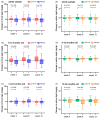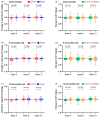Effect of Lacticaseibacillus paracasei N1115 on Immunomodulatory and Gut Microbial Composition in Young Children: A Randomized, Placebo-Controlled Study
- PMID: 37111189
- PMCID: PMC10145370
- DOI: 10.3390/nu15081970
Effect of Lacticaseibacillus paracasei N1115 on Immunomodulatory and Gut Microbial Composition in Young Children: A Randomized, Placebo-Controlled Study
Abstract
Lactobacillus paracasei N1115 (Lp N1115) was isolated from fermented milk products. The administration of Lp N1115 is safe and well tolerated in Chinese children, but its effectiveness among young Chinese children is still unclear. To investigate the efficacy of Lp N1115 as a probiotic to enhance gut development in Chinese infants and toddlers born by cesarean section, 109 healthy and cesarean-delivered infants aged 6-24 months were recruited for a 12-week randomized, placebo-controlled trial, with 101 finally completing the study. Saliva and stool samples were collected and detected at weeks 0, 4, 8, and 12 of the intervention. Statistical analyses were performed by using a per-protocol (PP) approach. After 12 weeks of intervention, the fecal pH in the control group increased (p = 0.003), while the fecal pH in the experimental group did not change. Salivary cortisol decreased from baseline in the experimental group (p = 0.023), while the control group showed little change. In addition, Lp N1115 increased the fecal sIgA content of infants aged 6-12 months (p = 0.044) but had no obvious effect on fecal calprotectin and saliva sIgA. At week 4, the increase in Lactobacillus relative to baseline was higher in the experimental group than in the control group (p = 0.019). Further analysis showed a trend toward a higher detection rate of Lactobacillus in the experimental group than in the control group (p = 0.039). In conclusion, Lp N1115 was able to enhance the content of Lactobacillus and maintain fecal pH levels. Its beneficial effects on gut development were more obvious in 6-12-month-old infants.
Keywords: Lacticaseibacillus; cesarean section; probiotic; young children.
Conflict of interest statement
S. Wang, Y. Xun, and Q. Yuan are employed by Shijiazhuang Junlebao Dairy Co., Ltd. and cooperated in designing the project. The authors declare no other conflict of interest.
Figures






Similar articles
-
A randomized, double blind, parallel, placebo-controlled study to investigate the efficacy of Lactobacillus paracasei N1115 in gut development of young children.Food Sci Nutr. 2021 Sep 1;9(11):6020-6030. doi: 10.1002/fsn3.2533. eCollection 2021 Nov. Food Sci Nutr. 2021. PMID: 34760234 Free PMC article.
-
Safety and tolerance of Lacticaseibacillus paracasei N1115 in caesarean-born young children: a randomised, placebo-controlled trial.Benef Microbes. 2022 Aug 3;13(3):205-220. doi: 10.3920/BM2021.0132. Epub 2022 Mar 18. Benef Microbes. 2022. PMID: 35300564 Clinical Trial.
-
Effects of Lactobacillus paracasei N1115 on gut microbial imbalance and liver function in patients with hepatitis B-related cirrhosis.World J Gastroenterol. 2024 Mar 21;30(11):1556-1571. doi: 10.3748/wjg.v30.i11.1556. World J Gastroenterol. 2024. PMID: 38617455 Free PMC article. Clinical Trial.
-
The Impact of Probiotics, Prebiotics, and Synbiotics during Pregnancy or Lactation on the Intestinal Microbiota of Children Born by Cesarean Section: A Systematic Review.Nutrients. 2022 Jan 14;14(2):341. doi: 10.3390/nu14020341. Nutrients. 2022. PMID: 35057522 Free PMC article.
-
Effects of a Fermented Dairy Drink Containing Lacticaseibacillus paracasei subsp. paracasei CNCM I-1518 (Lactobacillus casei CNCM I-1518) and the Standard Yogurt Cultures on the Incidence, Duration, and Severity of Common Infectious Diseases: A Systematic Review and Meta-Analysis of Randomized Controlled Trials.Nutrients. 2020 Nov 10;12(11):3443. doi: 10.3390/nu12113443. Nutrients. 2020. PMID: 33182682 Free PMC article.
Cited by
-
The Impact of Cesarean Section Delivery on Intestinal Microbiota: Mechanisms, Consequences, and Perspectives-A Systematic Review.Int J Mol Sci. 2024 Jan 15;25(2):1055. doi: 10.3390/ijms25021055. Int J Mol Sci. 2024. PMID: 38256127 Free PMC article.
-
Maternal-Foetal/Infant Interactions-Gut Microbiota and Immune Health.Biomedicines. 2024 Feb 22;12(3):490. doi: 10.3390/biomedicines12030490. Biomedicines. 2024. PMID: 38540103 Free PMC article. Review.
-
Shaping oral and intestinal microbiota and the immune system during the first 1,000 days of life.Front Pediatr. 2025 Jan 21;13:1471743. doi: 10.3389/fped.2025.1471743. eCollection 2025. Front Pediatr. 2025. PMID: 39906673 Free PMC article. Review.
-
Effect of Probiotics Supplementation on Cortisol Levels: A Systematic Review and Meta-Analysis.Nutrients. 2024 Oct 21;16(20):3564. doi: 10.3390/nu16203564. Nutrients. 2024. PMID: 39458560 Free PMC article.
-
Probiotic treatment induces changes in intestinal microbiota but does not alter SCFA levels in peritoneal dialysis patients-a randomized, placebo-controlled trial.Sci Rep. 2024 Dec 28;14(1):31413. doi: 10.1038/s41598-024-83056-5. Sci Rep. 2024. PMID: 39732948 Free PMC article. Clinical Trial.
References
-
- Miller J.E., Goldacre R., Moore H.C., Zeltzer J., Knight M., Morris C., Nowell S., Wood R., Carter K.W., Fathima P., et al. Mode of birth and risk of infection-related hospitalisation in childhood: A population cohort study of 7.17 million births from 4 high-income countries. PLoS Med. 2020;17:e1003429. doi: 10.1371/journal.pmed.1003429. - DOI - PMC - PubMed
Publication types
MeSH terms
Substances
Grants and funding
LinkOut - more resources
Full Text Sources
Miscellaneous

